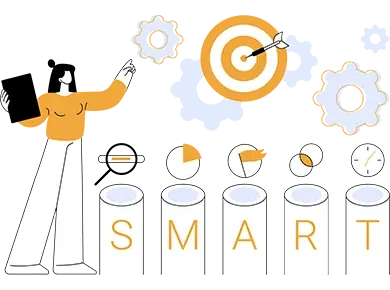Introduction
What is a To-do list
A To-do list can be any list in which you write down the tasks you want to do and the things you want to accomplish. What you do with it is what matters.
The importance and efficiency of a To-do list are given, first and foremost, by the purpose it serves. The reason why you set up that list will determine the way you prepare it and the way you’ll work with it.
Why use a To-do list
The main purpose of establishing and using To-do lists is to obtain a better organization of the activities that have to be carried out and above all, to remember each one of these activities.
Using a To-do list is a great way to plan and prioritize your activities so that you can do more things in a certain time frame. Therefore, a beneficial effect of using the To-do list is the increase in efficiency and productivity.
Where we can use the To-do list
You need planning and organization in both personal and professional life. Above that, you need to keep a good balance between the two. This proves that you need a To-do list in everything that involves an organized way of life.
When is needed To-do list
Some of the reasons you need to use a To-do list are the facts that you want to:
- live relaxed because you know exactly what to do right now and next;
- have control over your workday and improve your focus on important things;
- remember all the things you have to do and do the right thing at the right time;
- always be on time and meet your deadlines;
The enumeration may continue and may be different for each individual, depending on the particularities of the activities to be carried out.
Who needs To-do lists
If you want to work efficiently and to improve your lifestyle, then you need to plan your activities so that you can make the most of your time.
This is true whether you are an individual with a growth mindset, or a self-employed professional, or a small business owner. The most important factor is to want to thrive on all levels.
How to choose the most appropriate To-do list
Depending on the particularities of your life and the activities carried out, you can adapt both, the way you make the to-do list and the way you use it, to best serve your needs. Here are some features of to-do lists, so you can see which one works best for you.
Types of to-do lists
We currently make a lot of lists. So many that we sometimes conclude that we should have a list of lists so we don’t forget about some of them. Here are the most common types of lists:
- Daily tasks – includes tasks to be accomplished in one day. It is recommended that this list be prepared the previous evening and include hourly intervals for the tasks noted.
- Shopping list – from groceries or clothes to appliances, it all goes here. It does not require a date because it can be added when planning a shopping trip
- Ongoing projects – if you have several projects in progress then it is advisable for each one to make a list that includes the related tasks, which you can then plan
- Gifts to buy (for different anniversaries over a year) – it is usually included in the calendar where we note birthdays when we come up with ideas regarding the gifts we want (or need) to make on those occasions. It is important because it involves the allocation of a budget and this, in certain situations, must also be planned.
- Places to visit (and excursions to do) – if we note them then we increase our chances of performing them under optimal conditions because we can plan and organize them early
Classification criteria
To benefit from To-do lists it is recommended to classify activities according to certain parameters. This classification is beneficial because it helps us to plan and prioritize activities so that we make sure we execute the right thing at the right time. Here are some possible classification criteria for to-do lists:
- Importance of things to do. We set the following parameters for our tasks, depending on their importance: A=high, B=medium, C=low. Then we execute them in order A –> B -> C
- The urgency of things to do. Similar to the above procedure, we set parameters for our tasks, but this time depending on the urgency with which they must be solved: 1=high, 2=medium, 3=low.
- Contexts like similarity of the activities to be done, or the location of performing them, or the energy-based context. Any of these can help us order the To-do list
- Project-based system. This criterion implies the creation of a list of projects. Each project will have its own specific tasks list
Implementing
Each person should choose the work method suits best the specific needs. And besides that, it would be good for us to enjoy working with To-do lists, because we use them daily. For these reasons, regardless of whether we choose to work on paper or software, the most important thing is to feel comfortable using a To-do list. Some of the most used methods of implementing To-do lists are:
- Classic agenda, pen, and paper. Write down everything by hand, exactly as you wish
- Post-it on a wooden board. (or any board) By colors, by columns, however you want it, just displayed on sight
- Calendar. You get a direct schedule with the set time interval. Short and clear
- Online/offline software – increased flexibility in editing, continuous workflow, automatic calculations, and reports
Factors influencing their efficiency
Creating a To-do list that will help us work more efficiently and become more productive also relates to the following facts:
- Psychological – An overloaded to-do list can frustrate us because we will be dissatisfied with the outcome of the Planned VS Done. Negative emotions are one of the reasons why our productivity decreases. Just as when we get stressed because we have a too long To-do list. It is possible that at the end of the day you realize you didn’t do much but worry. Therefore, it is important to make rational planning and in perfect connection with reality.
- Consistency in respecting the planning – We have to do what we set out to do. If we keep postponing or rescheduling, in the end, we don’t solve anything else and just waste our time with unnecessary planning.
- Periodic review of lists – In time, some things no longer fit where they were originally planned. Maybe in the meantime, they have been solved, or maybe they just aren’t interesting to us anymore. Such tasks must be removed to avoid unnecessarily loading our lists
Working systems that incorporate To-do lists
To-do list is itself a useful tool, but adapted, processed and applied under certain conditions can bring us amazing results. Here are some of the systems for organizing activities based on the to-do list:
1. Ivy Lee method
This method involves the daily planning of 6 tasks, in no case more, and performing them in the order of importance. The method is simple and efficient and gives daily satisfaction of seeing your planned things fulfilled.
The Ivy Lee Method – Ivy Lee’s priority task list: an efficient way to boost your productivity
2. POSEC method
The method name is an acronym for “Prioritize by Organizing, Streamlining, Economizing and Contributing”. The basic idea of this method is to break down your main goals into minor goals and smaller tasks. Those will be accomplished one by one until the initial major goal is achieved. It also allows for keeping a good work-life balance.
POSEC Method – strategy for time management
3. The Eisenhower Matrix
It is based on categorizing and prioritizing tasks according to Importance, Urgency and the combination of these two. The matrix is the place where the tasks will be placed, each in the field related to its assigned characteristics. Depending on this placement, certain measures will be taken regarding the task
Eisenhower Matrix or Decision Matrix – a simple and efficient strategy to take action and organize your tasks
4. GTD (Getting Things Done)
David Allen’s patented methodology focuses on freeing your mind so you can better focus on what you are doing right now. This is done by recording planned tasks and projects externally and out of the mind. Subsequent processing involves breaking the recorded tasks and projects into actionable work items and finding the right solutions for them.
Getting things done (GTD), the action management system
5. Pomodoro technique
Applying it means that once you start working on a task, do that uninterrupted and focused for 25 minutes. After this time interval, a short pause is required, and after this process has been repeated 4 times, a longer pause of 23-30 minutes can be taken.
The Pomodoro technique – when time management is fun and enjoyable
6. Autofocus by Mark Forster
A simple and efficient time management system that emphasizes getting stuff done instead of getting stuff filed. Very flexible, this system allows you to choose what you want to work on. And this certainly provides a relaxed way of working
Autofocus – a simplified time management system
7. Agile Results
It applies the rule of 3 on various time intervals, to help you achieve both short- and long-term results. The Rule of 3, Monday Vision, Daily Outcomes, and Friday Reflection are patterns that give yourself a fresh start each day and each week.
Agile results – achieving more by doing less
8. 4D System
The name is an acronym for Delete, Delegate, Defer, and Do. The efficiency of implementing this method is enhanced by analyzing and revising the To-do list daily. It’s a simple method that has proven effective
4D system for filtering tasks – another simple yet effective time management method
9. Eat that Frog
The recognized method involves choosing the most important task and performing it first thing in the morning. Therefore, the recommendation is to consider work on it single-mindedly until it’s complete.
Eat that frog to beat procrastination and accomplish more
10. 168 Hours
From the start, the name of “168 hours” of Laura Vanderkam method makes us aware of the time available in a week. Being aware of it, with a bit of reorganization and prioritization, we can spend more time doing exactly what we want, without making sacrifices for it.
168 hours each week. Track and enjoy each hour
11. Do it tomorrow
Or Get everything done and still have time to play by Mark Forster. A new approach to time management that starts with your list of commitments organized by Categories and Projects turned into a checklist. The way of working is in time bursts.
Do it tomorrow, a new approach of time management
12. Kanban Method
brings transparency to the whole work process by displaying on a board every single one of your tasks. None gets lost, all gets done. A visual process that brings order to chaotic work processes.
Kanban – the visual scheduling system
Important to keep in mind while working with to-do list
- Pareto’s principle. It also applies to the planning and prioritization of activities through To-do lists. According to this principle, “80% of the effects come from 20% of the causes “. Therefore we conclude that we must be “focusing in on the 20 percent of activities that produce 80 percent of your desired results”
- Parkinson’s Law states that “work expands to fill the time available for its completion”. It is very important to set deadlines even when we don’t need to. The fact that we have planned a certain time frame for carrying out a task mobilizes us to become efficient and productive and to finish the activity at the established deadline.
- Single-tasking. We would like it to be different, but the human brain can focus on one thing at a time. To work efficiently we have to work on one task at a time, and not move on to the next one when the active one is completed. If we focus all our attention on a single task we focus better and this is noticeable in productivity.
- A good rest. A good night’s sleep and a nap during the day can do wonders with our efficiency and productivity. A rested brain is more creative. Calculate the sleep hours recommended for you, and schedule them exactly as you want to, with PlanArty’s Sleep Calculator






